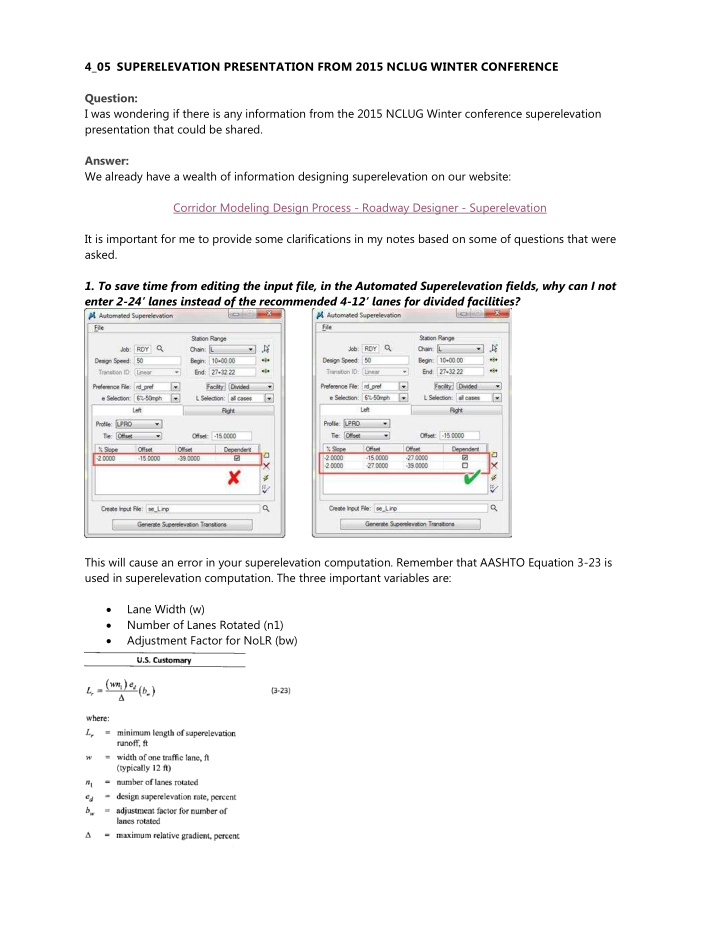



4_05 SUPERELEVATION PRESENTATION FROM 2015 NCLUG WINTER CONFERENCE Question: I was wondering if there is any information from the 2015 NCLUG Winter conference superelevation presentation that could be shared. Answer: We already have a wealth of information designing superelevation on our website: Corridor Modeling Design Process - Roadway Designer - Superelevation It is important for me to provide some clarifications in my notes based on some of questions that were asked. 1. To save time from editing the input file, in the Automated Superelevation fields, why can I not enter 2- 24’ lanes instead of the recommended 4- 12’ lanes for divided facilities? This will cause an error in your superelevation computation. Remember that AASHTO Equation 3-23 is used in superelevation computation. The three important variables are: Lane Width (w) Number of Lanes Rotated (n1) Adjustment Factor for NoLR (bw)
Given1: w=12’ Lanes n1=2 lanes rotated (4 lanes total) e=6% bw=0.75 50 MPH Design Speed à MRG = 0.5 LRoff = ((12x2)6/0.5)x0.75= 216’ Given2: w=24’ Lanes n1=1 lane rotated (2 lanes total) e=6% bw=1 50 MPH Design Speed à MRG = 0.5 LRoff = ((24x1)6/0.5)x1= 288’ Note that Geopak will determine a LRoff = 144’ for the second computation above. Its logic can be explained in the next question. 2. What is the difference between selecting the Length of Runoff from the AASHTO Tables versus calculating with the Maximum Relative Gradients (MRG) formula, Equation 3-23? The main difference being the tables assume a nominal 12’ wide lane. The MRG formula can be used for computation of any lane widths. However, it is important to note that we have set the default parameters for the Geopak Superelevation Preferences file (.sep) to adhere to the nominal 12’ lane rule. This is in compliance with AASHTO guidelines. Thus Given3: w=24’ Lanes n1=1 lane rotated (2 lanes total) e=6% bw=1 50 MPH Design Speed à MRG = 0.5 LRoff = (( 12 x1)6/0.5)x1= 144’ Either way, both computations #2 and #3 are incorrect and not recommended.
3. How do I override the default AASHTO tables method? I want to use the MRG formula for all cases. In the rd_pref.sep , change these three configurations: Runoff Length Method: e Table à Relative Gradient Table Table Name: english_2004_eTable_l.csv à english_2004_RGtable_l.csv Width Basis: Nominal Lane Width à Actual Lane Width Note other default configurations: e Interpolation (AASHTO Tables): Closest Entry (Round to nearest, up or down) Considered Half Lane if Width < 9.00 (for undivided facilities middle turning lane usually 14’ - 16’ wide, 7’ - 8’ off centerline. It determines the number of lanes rotated and the adjustment factor, e.g. 1.5 lanes rotated, bw=0.83) Length Rounding Increment: 1 , so you do not have a LRoff = 134.3’ 4. Are there any newer than 2004 AASHTO superelevation tables delivered by Bentley Geopak? No. There is no need. I’ve spoken with Ron Allen, Roadway Manager then, in 2005 on the topic. There has been little change in the Green Book for superelevation, except for starting from 2004 to 2011 the side friction factor (f) has changed for low speed urban street, less than 45 MPH design speed. This small change does not have an affected on how we compute our standard superelevation using the AASHTO Tables Method. The 2004 table values have been verified and consistent with the 2011 Green Book. I’ve also used a “retro - fitted” superelevation table from Sum Lim of Geopak at the time. 5. If my typical is a 4-lane divided facility and I am adding and dropping outside turning lanes, should I compute for 3 lanes rotated or stick with the typical section of 2-lane rotation? This is common for superstreet and R-CUT projects. Engineering judgement should be exercised. There is nothing in the book which mention this situation. For my recommendation, three scenarios to consider: If it’s an undivided facility, where the superelevation sections are joined at the centerline, what is done to one side has a direct effect on the other side. In other words, if the length of runoff is adjusted for the additional lane of the right side, then same transition (consistent length and rate) must be applied to the left side, even though there are no additional lanes on the left.
If it’s a divided facility, the superelevation sections are not joined. Therefore, the transition can be independent. Care should be taken for excessive deviation from the normal superelevation transition. Whether to even adjust for the additional lanes really depends where lane tapers occur. If the additional lane(s) occur more than 50% of the transition (Length of Runoff + Tangent Runout), then this is conservative number worth considering. 66-75% is probably more practical. These are just my recommendations. Your Project Engineers/Squad Leaders may other preferences and criteria to use. 6. What is the “all - cases” in the L Section field mean (Automated Superelevation)? Prior to the 2004 Green Book, LRunoff was selected from various emax tables. Notice the “gap” in certain fields.
Starting with 2004 and 2011, all emax tables are combined into one with consistent LRunoff values (no gaps)… thus “all cases”? Should be mostly consistent with the 2011 AASHTO Tables. Note that Geopak first computes the length of runoff for one lane rotation. Then later on finalize the value with the adjustment factor for the actual number of lanes rotated, e.g. 144’ (1 -lane rotation) x 1.5 (2-lane rotation) = 216’. The “1” and “2” lanes columns in the AASHTO table above do not have anything to do with whether it is an undivided or divided facility. Median width is not part of the superelevation computation.
Recommend
More recommend